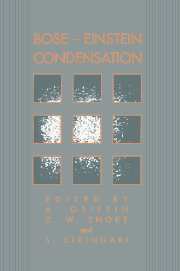Book contents
- Frontmatter
- Contents
- Preface
- Preface to paperback edition
- 1 Introduction: Unifying Themes of Bose–Einstein Condensation
- Part one Review Papers
- Part two Brief Reports
- 20 BEC in Ultra-cold Cesium: Collisional Constraints
- 21 BEC and the Relaxation Explosion in Magnetically Trapped Atomic Hydrogen
- 22 Quest for Kosterlitz–Thouless Transition in Two-Dimensional Atomic Hydrogen
- 23 BEC of Biexcitons in CuCl
- 24 The Influence of Polariton Effects on BEC of Biexcitons
- 25 Light-Induced BEC of Excitons and Biexcitons
- 26 Evolution of a Nonequilibrium Polariton Condensate
- 27 Excitonic Superfluidity in Cu2O
- 28 On the Bose–Einstein Condensation of Excitons: Finite-lifetime Composite Bosons
- 29 Charged Bosons in Quantum Heterostructures
- 30 Evidence for Bipolaronic Bose-liquid and BEC in High-Tc Oxides
- 31 The Dynamic Structure Function of Bose Liquids in the Deep Inelastic Regime
- 32 Possibilities for BEC of Positronium
- 33 Bose–Einstein Condensation and Spin Waves
- 34 Universal Behaviour within the Nozières–Schmitt-Rink Theory
- 35 Bound States and Superfluidity in Strongly Coupled Fermion Systems
- 36 Onset of Superfluidity in Nuclear Matter
- Appendix. BEC 93 Participant List
- Index
27 - Excitonic Superfluidity in Cu2O
Published online by Cambridge University Press: 15 December 2009
- Frontmatter
- Contents
- Preface
- Preface to paperback edition
- 1 Introduction: Unifying Themes of Bose–Einstein Condensation
- Part one Review Papers
- Part two Brief Reports
- 20 BEC in Ultra-cold Cesium: Collisional Constraints
- 21 BEC and the Relaxation Explosion in Magnetically Trapped Atomic Hydrogen
- 22 Quest for Kosterlitz–Thouless Transition in Two-Dimensional Atomic Hydrogen
- 23 BEC of Biexcitons in CuCl
- 24 The Influence of Polariton Effects on BEC of Biexcitons
- 25 Light-Induced BEC of Excitons and Biexcitons
- 26 Evolution of a Nonequilibrium Polariton Condensate
- 27 Excitonic Superfluidity in Cu2O
- 28 On the Bose–Einstein Condensation of Excitons: Finite-lifetime Composite Bosons
- 29 Charged Bosons in Quantum Heterostructures
- 30 Evidence for Bipolaronic Bose-liquid and BEC in High-Tc Oxides
- 31 The Dynamic Structure Function of Bose Liquids in the Deep Inelastic Regime
- 32 Possibilities for BEC of Positronium
- 33 Bose–Einstein Condensation and Spin Waves
- 34 Universal Behaviour within the Nozières–Schmitt-Rink Theory
- 35 Bound States and Superfluidity in Strongly Coupled Fermion Systems
- 36 Onset of Superfluidity in Nuclear Matter
- Appendix. BEC 93 Participant List
- Index
Summary
Abstract
Using the exciton-mediated photovoltaic effect, we examine exciton transport over large distances in Cu2O as a function of temperature and particle density. Evidence for a phase transition at low temperatures and high densities is attributed to the onset of excitonic superfluidity.
We have performed exciton transport measurements over a range of temperatures and exciton densities in ultrapure, oriented large Cu2O single crystals. A sketch of the experimental method is shown in Fig. 1. The crystal is illuminated on the back surface by 10 ns pulses from a frequency-doubled YAG laser (λ = 532 nm). The initial exciton density created over an absorption depth (about one micron at λ = 532 nm) can be varied by inserting calibrated neutral density filters in the laser beam, reaching values of up to 1019 cm−3. The excitons which have migrated to the opposite face of the crystal are dissociated into free carriers by the high electric field near the Cu Schottky contact [1] deposited in a comb configuration together with an ohmic Au electrode, resulting in an external current. A time-resolved measurement of that current will give the velocity distribution of the excitons migrating through the crystal. This method of detection – as opposed to photoluminescence – is particularly well suited to the study of optically inactive paraexcitons in Cu2O; moreover, since the migration time is of the order of one microsecond as compared to the lifetime of 13 μs [2] for paraexcitons, recombination processes have little influence on the measurements.
- Type
- Chapter
- Information
- Bose-Einstein Condensation , pp. 519 - 523Publisher: Cambridge University PressPrint publication year: 1995
- 1
- Cited by



